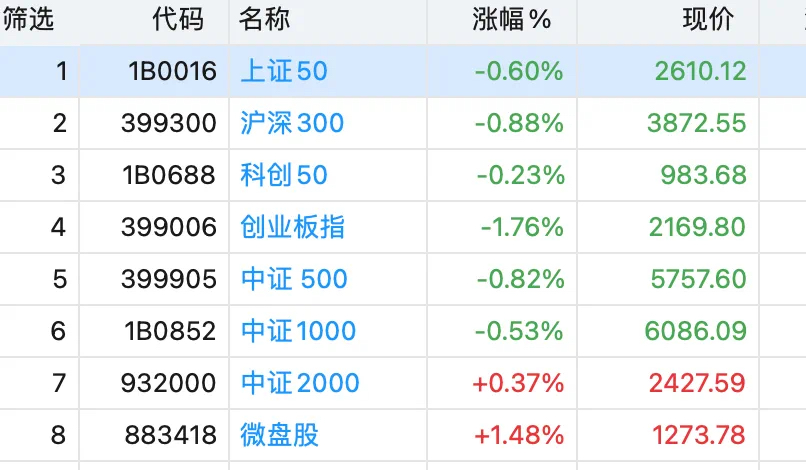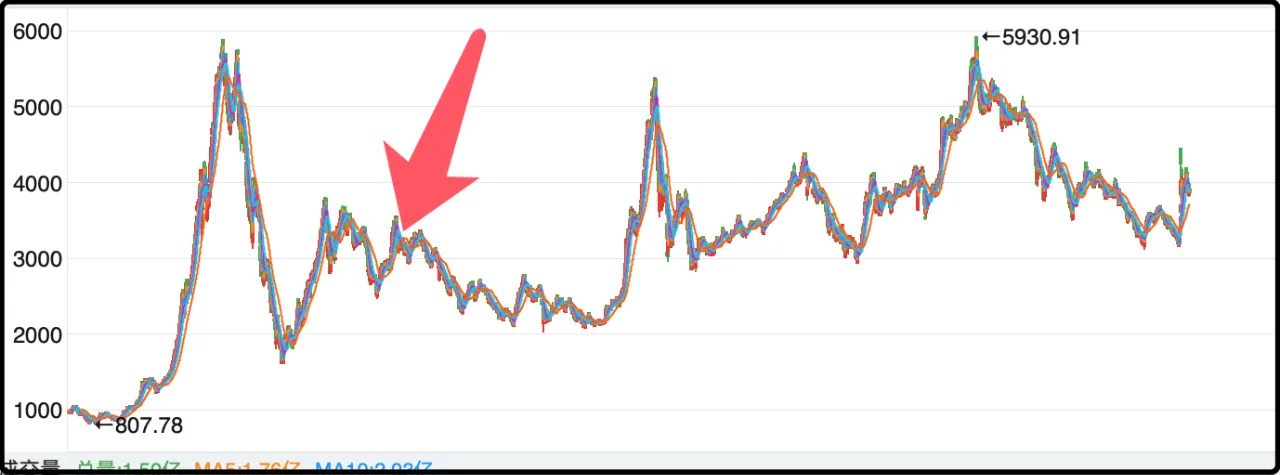Today, the two markets traded 1.49 trillion yuan, continuing to hover below 1.5 trillion yuan. 1.5 trillion yuan would be a high volume level in the first half of the year, but it is a low volume level after the 9.24 market. If the market cannot even reach 1.5 trillion yuan, it will be difficult to develop a decent market.
Today's market median was -0.1%, and individual stocks as a whole performed better than the index, because today's market style has returned to its old state, with small and micro-cap stocks continuing to be active and large-cap stocks quietly falling.

When the market style rebounded yesterday and the day before yesterday, I only said that a single-day fluctuation could not explain the problem. If I were to analyze and prove it seriously, I would now be desperately trying to make up for it and make the logic right.
In fact, I have thought about the reasons for the downturn in the weight stocks over the past year. It is very likely that foreign capital has continued to sell net. The years when the weight stocks were the best were also the years when foreign capital bought the largest amount of shares. At that time, you could make money by buying the top 30 stocks in the northbound channel holdings list with your eyes closed. However, since last year, foreign capital has been selling A shares as a whole, and the weight stocks have not worked.
Now the northbound data is not updated in real time, I can't see the details, I can only judge by feeling that foreign capital has flowed out as a whole since October. In fact, there is no need for foreign capital to flow out, as long as foreign capital is not a net inflow, the heavyweight stocks will not be good. I used to make an analogy that the A-share market is like a leaking tire, no one has fixed the leak for many years, and it has been supported by the inflow of foreign capital and retail investors for so many years. Foreign capital has fled, and retail investors have not increased their positions, so the tire will slowly become deflated.
The big speculators are not just speculating blindly, they have seen the situation clearly and would rather choose some small-cap stocks to gamble on the air than be a hard-working sedan bearer.
There is no emotional explosion in the current market, so it may maintain weak fluctuations. But if you ask me if there is a chance to reach 3,800 or even 4,000, I can only say that there is always a chance. A-shares are a lunatic. If it suddenly has a big surge like it did at the end of September, it may go up in 10 days or half a month.
The rise of A-shares is always hot but short-lived. You can only catch that wave if you stay in the market for a long time. In order to catch that wave, you have to pay a huge price of time and emotional torment. If you go through a long period, such as 10 years, and calculate the overall rate of return of the market, the cost performance is actually not very good, and it may not even outperform GDP.
I am not just making this up, I can do the math for you. For example, compared to November 28, 2010, the ChiNext Index today has increased by 77%. If you calculate compound interest over 14 years, it is a little over 4% annualized. The ChiNext Index is already the index with the best return rate. If you calculate the CSI 300 and CSI 500, the annualized return rate is only a pitiful 1%, which is not even as good as the bank interest rate.
Some people may wonder whether November 28, 2010 was the high point, but it was not. I will post a chart of the Shanghai and Shenzhen 300 Index over the past 18 years. Today in 2010 is the position indicated by the red arrow.

Or let's assume an ideal situation. You entered the market in June 2013 and bought at the lowest point of the CSI 300 in the past 15 years (2023 points). Then the cumulative return until today is 91%, equivalent to an annualized rate of 6%. This is the best result after activating the time machine cheat.
If there are new investors around you, it is recommended that you send the above paragraph to them.
……
1. Trump said that he would impose a 10% tariff on Chinese goods from the first day of his presidency. This is just the first step. There will be gradual tax increases in the future, and the tax rate will eventually increase by 25-30% during his term. As for the 60% reported by the media before, it is only the highest tax rate for a small number of goods. Foreign institutions generally believe that China will appropriately devalue the RMB to cope with the new tariff structure. I just looked at their forecasts for the exchange rate at the end of 2025 today. Societe Generale is the most optimistic about the RMB. The forecast value they gave is 7.1, and most of the remaining institutions fall in the range of 7.5-7.6.
Trump also persuaded the Mexican president to agree to organize immigrants to enter the United States from Mexico, which cut off the channel for the traitors. In the past two years, nearly 100,000 Chinese flew to Venezuela and then walked for a month through five or six countries to sneak into the United States. The Biden administration does not care about illegal immigration. After Trump came to power, he built a wall on the border, so it is impossible to sneak through the wall again.
2. Today, the new round of centralized procurement in the pharmaceutical industry has seen an overall price reduction of 63%. 91 new drugs have been added to the catalog, of which 38 are new innovative drugs in the world, and 65 of these 91 new drugs are domestically produced. Overall, the government's attitude of supporting innovative drugs is very clear, but the market has not responded. The CSI Pharmaceutical and Innovative Drug Indexes are both green today. The pharmaceutical sector is too big, and if you want to pull it up, small stimulus is useless. It must be a big positive that breaks the circle.
3. Yesterday I saw the most searched headline, "Do those who paid off their mortgages early regret it?" It was written by China Business News. It made me laugh. Do today's journalists have no contact with the market at all? Currently, large-denomination certificates of deposit only have an interest rate of 1.8-1.9%, and bank financial management generally only has an interest rate of 2%+. Why would you regret paying off a 3.3% mortgage early?
Now, the only way to outperform mortgage fixed income is to buy public bonds. The one I have recommended many times in the night report has an annualized return of about 4%, but the net value of public bonds fluctuates. Many people panic when there is a short-term decline of more than 0.5%. If you have poor pressure-bearing ability, just deposit your money in the bank honestly. Don't complain about the low interest rate, at least it saves you the worry.
That's all. A few days ago I sold 1 million mining coins. The average price was 0.2-0.3 dollars. Then it was listed on the exchange and the price went up to 1.3 dollars. I smiled and said I missed out on 1 million dollars. But the next day the price was 2.3 dollars. Today it's 3.3 dollars. I've grown tired and can't laugh anymore.
Of course, I missed out on 3 million dollars just for show effect. I calculated it for fun. Even if I didn’t sell all the coins I mined and kept them until they were listed, it would be difficult to get them on the third day. It’s a pity, but if there is another 10 times in the parallel universe, I will probably sell them as soon as I mine them. More than 90% of the coins I threw away have returned to zero. It’s very rare for the price to reverse. We can’t just wait for a dead rabbit from a tree stump.
When investing, I don’t pursue getting rich overnight, but focus on the certainty of the rate of return. Between a stable annualized return of 30% and a 10% chance of earning 500%, I would choose the former, even if the latter has a higher mathematical expectation.
The above explanation is valid until the price does not exceed $4. If it exceeds, or exceeds by too much, I reserve the right to break my defense and curse.